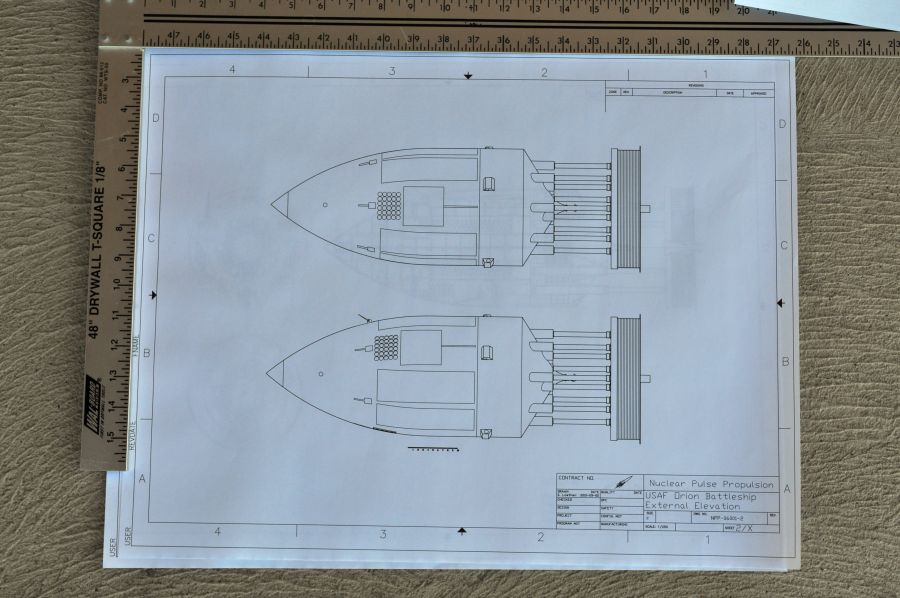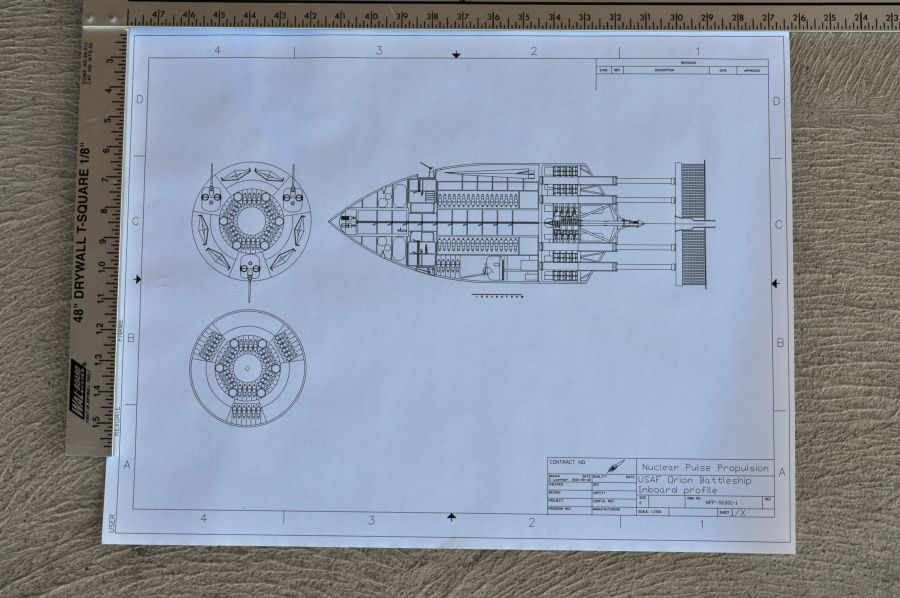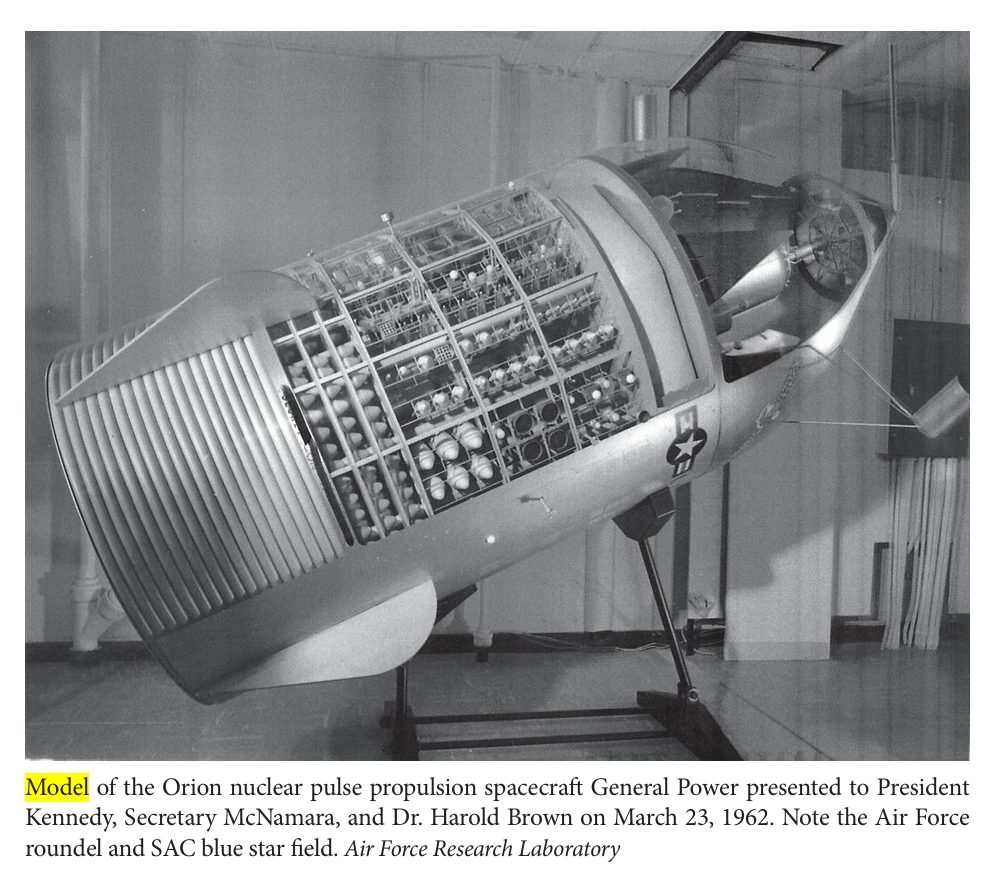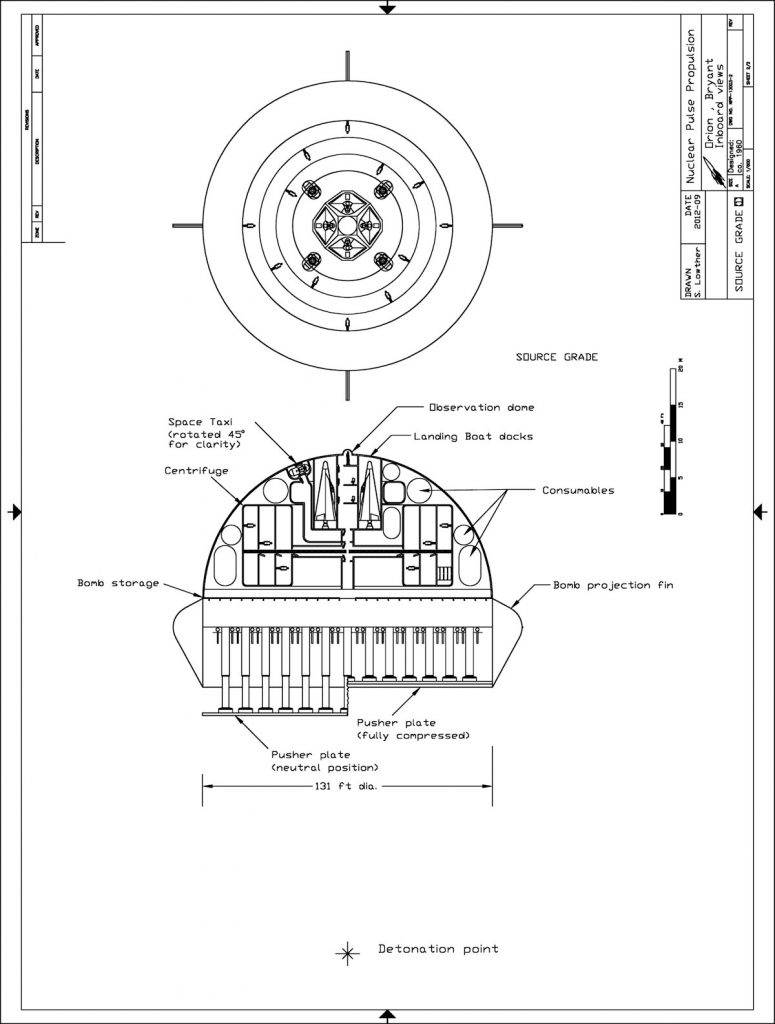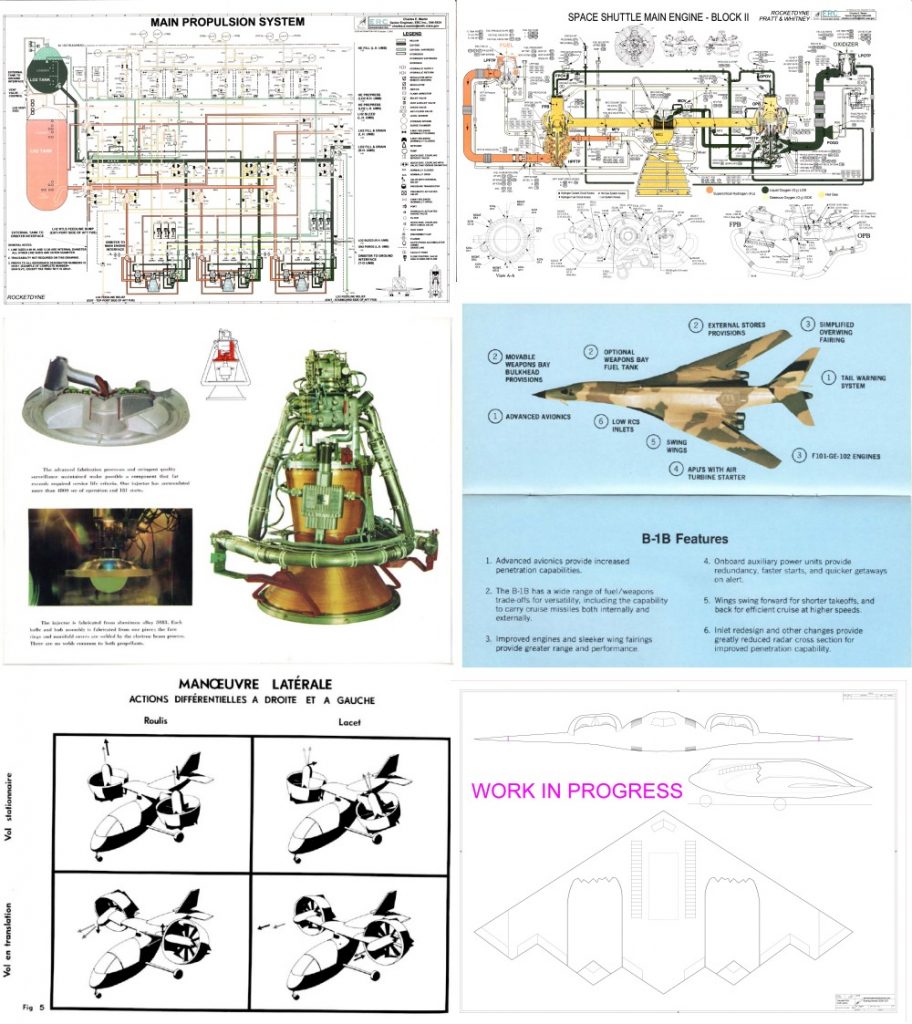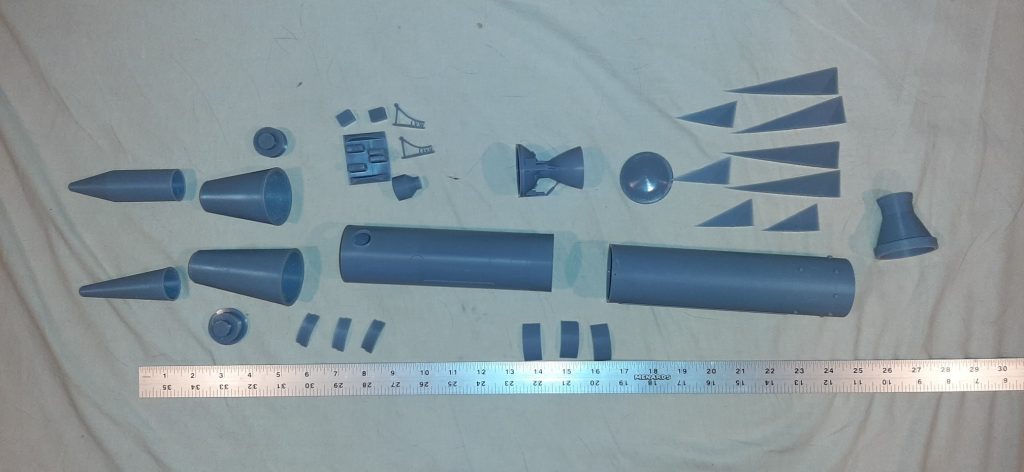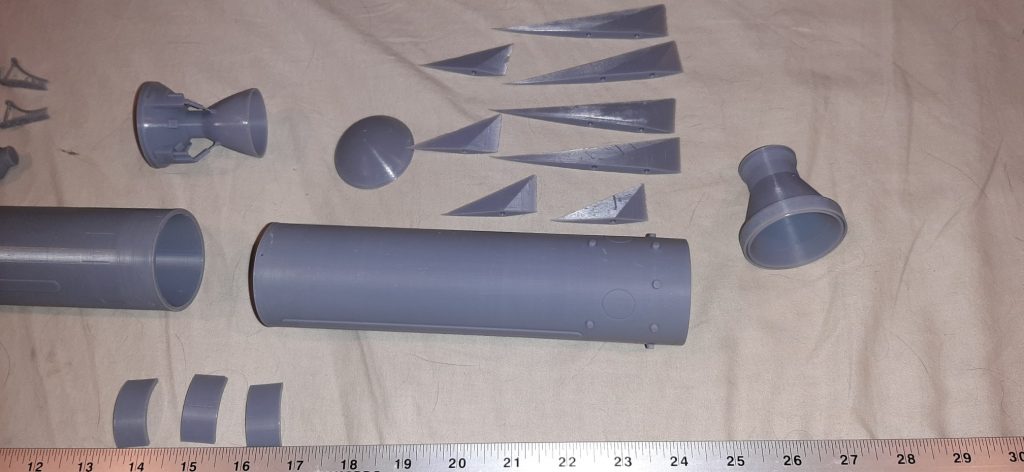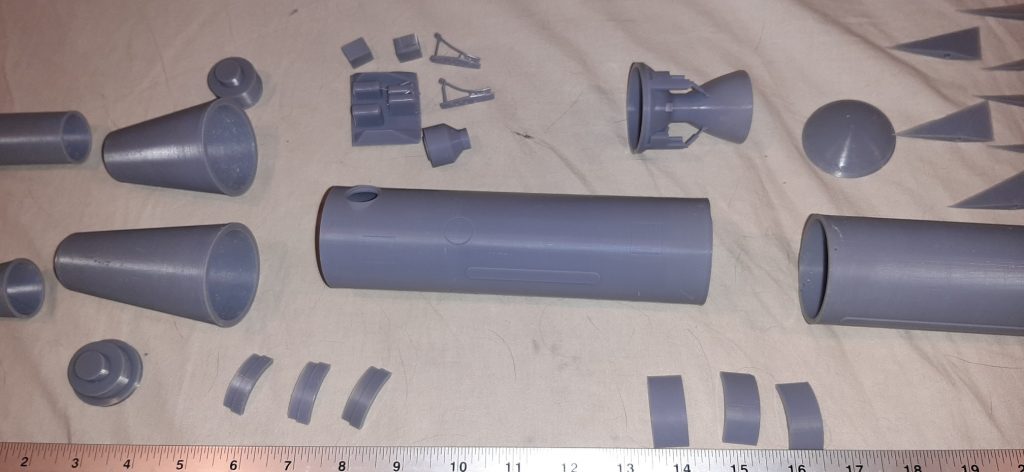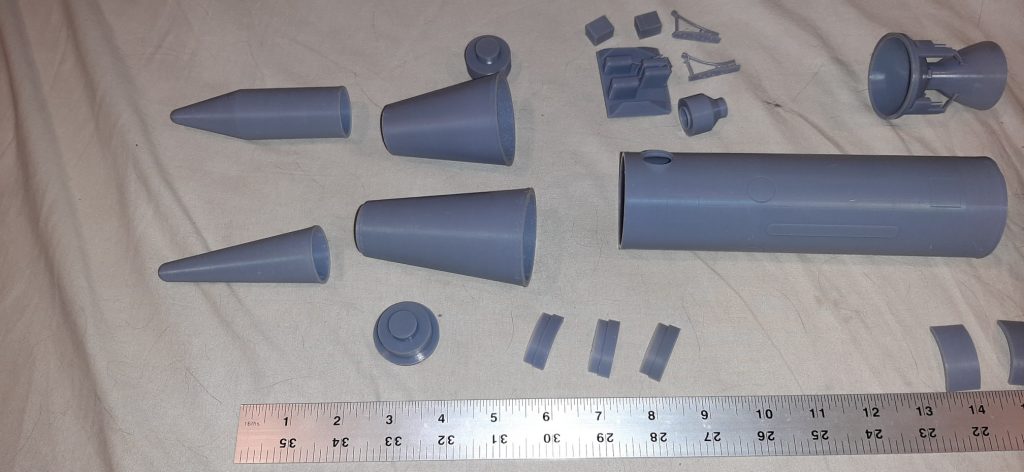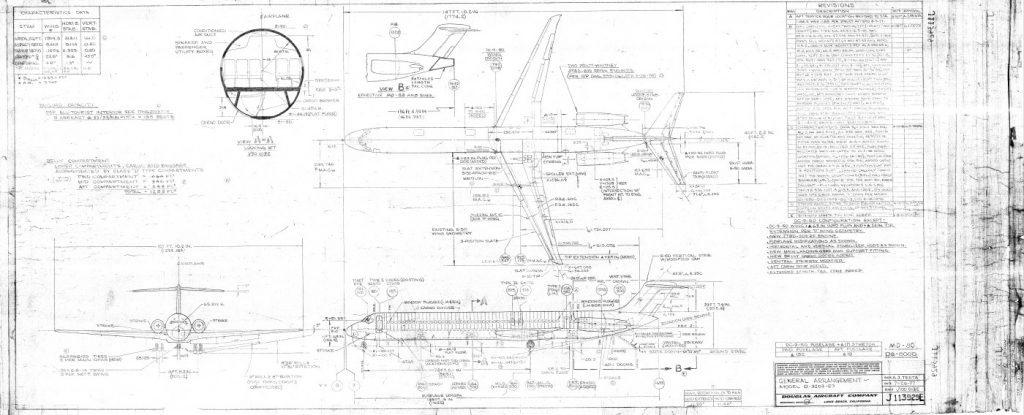Protected: October Rewards Catalogs
Protected: September Rewards Catalogs
Rumored and discussed for years, in 1962 General Atomic reportedly built a “Corvette sized” display model of the 4,000 ton Orion spacecraft as a spacegoing battleship. This model was shown to President Kennedy, and the reported reaction was… not great. The model was described by a few who had seen it, but all evidence of the model vanished, with the presumption that the model itself was either destroyed or lost, probably shut in a crate next to the Ark.
Well over a decade ago I took those scraps of description, coupled with random bits of data, discussions with a few who knew things, and some imagination, and pieced together my own interpretation of what the Orion Battleship may have looked like.
Some printouts of my diagrams, years ago:
Somewhat to my surprise, my diagrams have been spread far and wide and have become the de facto canonical image of the Orion Battleship, with sketches, 3D CAD models, paintings, etc. being made based to greater or lesser degrees on my design. My one real contribution, I guess. I’ve never tried to claim that it was accurate, just that it was the best that I could do with what I had. I never expected to be able to do better.
But then author Brent D. Ziarnick published the book “To Rule the Skies” in 2021. In it was, at last, a photo of the model. While the book was published 3 years ago, I only stumbled across this image today:
There are *clear* differences between the model and my interpretation. Mostly they involve the means of projecting the pulse units: I based my design on the system used for the 1963 4,000 ton Orion: a cannon along the ships centerline that shot the pulse units directly aft through a central hole in the pusher plate. But the model depicted an older, more cumbersome approach: those “fins” on the side are actually rails. They’d lob the pulse units past the edge of the plate. I now this because circa 2009-12 I communicated with Jim Bryant, who was an artist at General Atomic and he created a sketch for me of Orion as he knew it at about the time the model was made. From his sketch I created CAD diagrams:
You put my two diagrams together… and you get pretty close to the configuration shown in the model.
I’ve got high hopes for getting an improved-rez version of the photo (maybe more!). I will use that to create a new set of diagram, probably also a 3D model, of the *official* “Orion Battleship.”
I don’t feel too bad about getting some things dead wrong. The Orion concept was in serious flux at the time; had the USAF proceeded with the battleship, it would *not* have used the pulse unit “fins.” Instead it would have evolved to something like what I drew up. It could well have evolved *past* what I drew up, but that’s a question that can only be answered in an alternate reality.
If you want the full Orion Battleship Experience, check out Aerospace Projects Review issue V2N2:
https://www.aerospaceprojectsreview.com/ev2n2.htm
The rewards went out this AM bright and early. They include:
Diagram: Two sheets of Rocketdyne schematics for the Space Shuttle Main Engine and propulsion system
Document: “B-1B New Strength for America’s Defense” An early 80’s brochure on the then-forthcoming B-1B
Document: “Aerojet propulsion for Space Systems,” a very nicely illustrated booklet on the AJ10-137, the main engine of the Apollo CSM
Document: Two articles in French on VTOL Aircraft from the ICARE revue De L’Aviation Francaise “Salon 69”
CAD Diagram: WIP of the Boeing Model 2000-201 VTOL stealth spec ops transport
If you are interested in helping to preserve this sort of aerospace history, consider signing up for the APR Monthly Historical Documents Program for as little as $1.50 per month:
https://www.aerospaceprojectsreview.com/monthly.htm
Protected: August Rewards Catalogs
The USSF wants to actually be able to do their job. Could we see the return of the heady days of the Star Wars program? Now that we have actual almost-affordable and mostly-reusable space launch, we just might. Get ready for the pages of Aviation Week to be filled with artists concepts of space based lasers, neutral particle beams, orbital and cisluanr assets of all kinds. Can we even dream of manned nuclear powered spacecraft patrolling the spacelanes?
Of course, a lot will depend on November.
https://www.sbir.gov/topics/11201
OBJECTIVE: The end state of this project is to establish a robust and sustainable framework for Space Sustainment and Maneuver, enabling companies to facilitate movement within the space domain across all orbital regimes, including travel to and from the moon. This initiative aims to overcome current limitations in maneuverability, thereby providing strategic advantages in space operations, such as maintaining initiative, achieving surprise, and outmaneuvering adversaries. By fostering innovation in areas such as on-orbit servicing, refueling, orbital transfer/maneuvers , and payload capabilities, the project seeks to ensure the survivability and effectiveness of space assets in NextGen Warfare scenarios. DESCRIPTION: The work to be accomplished entails a comprehensive exploration of space sustainment and maneuver technologies aimed at advancing superiority in orbital operations. This endeavor encompasses multiple facets, including but not limited to: 1. Core Technology Development: Refining and optimizing sustainment and maneuver solutions for improved maneuverability, efficiency, and strategic advantage. 2. Prototyping and Testing: Developing and testing key components like payloads, refueling systems, and autonomous maneuver strategies. 3. Advanced Payload Systems: Integrating space domain awareness, cognitive radios, on-orbit servicing , and electromagnetic spectrum capabilities. 4. Innovative Refueling Technologies: Implementing innovative solutions, such as optimized propellant selection and architectures for on-orbit refueling. 5. Next-Generation Orbital Transfer/Maneuvers Strategies: Developing efficient orbital transfer/ Maneuver techniques for prolonged asset lifespan and gaining a strategic advantage. 6. Logistics Architecture: Designing robust on-orbit systems for resource management, maintenance, and repair in extended space operations. 7. Enhanced Security Measures: Implementing data protection, cybersecurity, and edge computing solutions for space assets. 8. Integration with Existing Systems: Ensuring seamless integration with current space infrastructure and operational processes.
Here’s the first nearly complete set of “sellable” 1/18 scale Skybolt ALBM parts. Only things missing are a stand(s) and a clear cover for the star tracker. There’ll be 2 variants… complete, and a simpler one without most of the innards (build with the stages/warhead joined). It takes about 2 *days* to print a complete set of parts. I’m still pondering the price. I will probably start on the low end and raise the price as I realize just what the frak I’m doing. Probably something along the lines of $80-$100, + postage. If interested, let me know.
A general arrangement diagram of the Douglas Model D-3203-29. This was a modified DC-9-50, appears to be the basic design for the MD-80, dated 7-26-1977.
The full-rez scan (more than ten times larger than this one) has been made available as a bonus to above-$10 subscribers and Patrons. If interested in such things, consider subscribing:
https://www.aerospaceprojectsreview.com/monthly.htm
I’ve shut down production of cyanotype blueprints for the time being. What I’ve got is what there is; I’ll leave the catalog page up while I still have a supply, but I’ll shut it down when I run low and sell the rest on ebay. Get ’em while ya can.
https://www.aerospaceprojectsreview.com/catalog/cyan.htm
